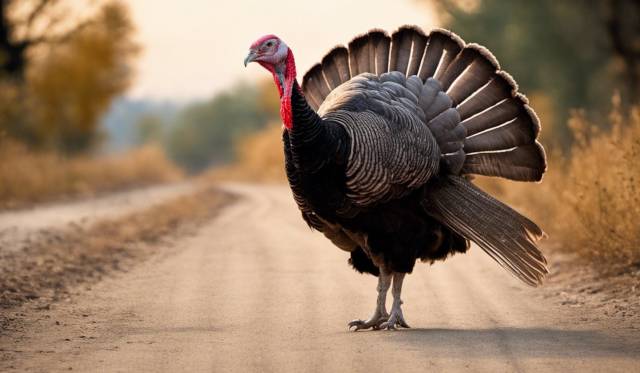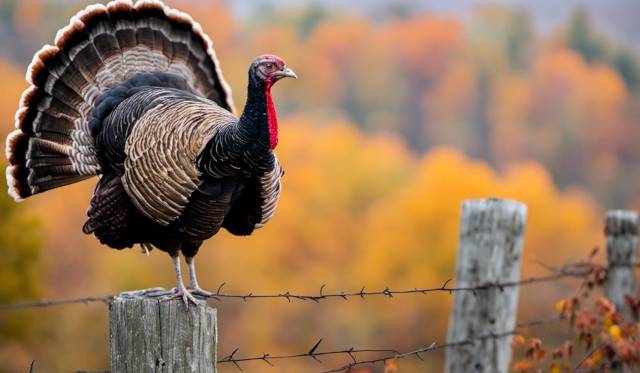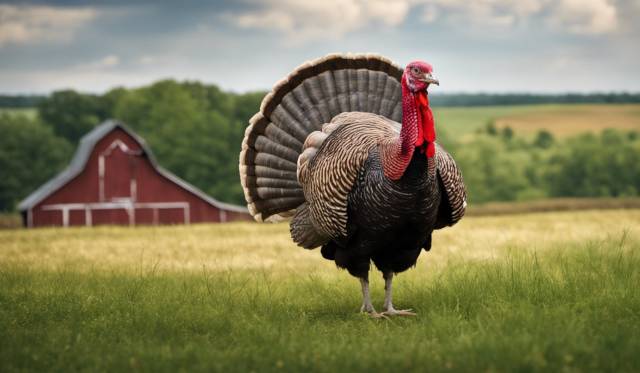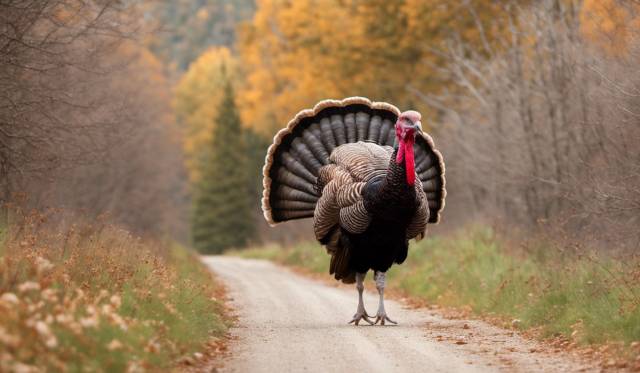Wild turkeys have a reputation for being difficult to hunt due to their excellent eyesight. Many hunters believe that turkeys can see them from miles away, making it almost impossible to get close enough for a good shot. But do turkeys have good eyesight?

In this article, we will take a look at the science behind turkey vision and what a turkey hunter should know when trying to outsmart these elusive birds.
Contents
Understanding Turkey Eyesight
Wild turkeys have remarkable eyesight, which is essential for their survival. Their eyes are capable of detecting movement and assimilating detail at an astonishing rate. With eyes positioned on the sides of their heads, turkeys have impressive peripheral vision.
Turkeys primarily rely on their exceptional daylight vision to locate food, catch potential prey like insects, and keep safe while running or flying.
How Far Can A Turkey See
A wild turkey’s field of vision spans roughly 270 degrees, and with just a slight turn of its head, it can see almost 360 degrees around.
Their keen sense of vision becomes even more impressive when considering the distance they can see. While the exact distance a turkey can perceive varies depending on numerous factors, such as lighting and environmental conditions, their ability to spot potential danger or detect predators from a considerable distance cannot be underestimated.
Monocular Vision
Turkeys have monocular vision, which means their eyeballs function independently of one another. This is in contrast to our binocular vision, where both of our eyes work together.
Turkey Retina
A turkey’s retina is quite complex, with some experts even claiming that turkeys and their avian relatives possess the most complex retinas of any vertebrate. Their retinas contain cones, which are photoreceptors responsible for color vision.
Additionally, turkeys have one rod, which is responsible for night vision. This combination allows them to see a wide range of colors and effectively detect movement.
In terms of visual acuity, a turkey’s eyesight is incredibly sharp. This keen sense of vision has made them an elusive prey species for hunters, as they can easily detect any sudden movements or signs of danger. With such an impressive visual field, turkeys have a clear advantage when it comes to avoiding detection in their natural habitat.

Can Turkeys See Better Than Deer?
Yes, turkeys can see slightly better than deer. In terms of overall clarity and acuity, turkeys have the upper hand.
When it comes to comparing the eyesight of turkeys and deer, both animals possess unique visual advantages. Wild turkeys have excellent vision, which allows them to identify tiny details in their surroundings, which can be critical for detecting approaching danger.
Deer, on the other hand, are known for their nocturnal vision capabilities and their ability to see UV light. While their vision has evolved for a different set of survival needs, the general consensus is that turkeys possess sharper eyesight when it comes to detecting movement and spotting fine details.
Turkeys’ Visual Spectrum
Turkeys have a remarkable visual spectrum, comprising excellent color vision and sensitivity to UV light. Their monocular, periscopic vision provides them with a wide field of view.
Are Turkeys Color Blind?
No, turkeys are not colorblind. In fact, they have excellent color vision, with a large field of vision and exceptional clarity.
Wild turkeys’ eyes contain structures called rods and cones, allowing them to perceive a broad spectrum of colors thanks to their photoreceptors and flattened corneas, which are much better than humans. Having the ability to see a wide range of colors, patterns, and shapes assists them in recognizing food sources, mates, and environmental cues.
Another aspect of a turkey’s field of vision worth mentioning is their monocular, periscopic vision, which is a result of their eyes being located on the sides of their heads. This type of vision allows the turkeys to have a wide field of view, but it also affects their depth perception. Binocular vision, by comparison, is better for judging distance more quickly.
Ultraviolet Light Spectrum
Besides their ability to see an array of colors, turkeys also have great sensitivity to UV light. Their eyes are adapted to detect the UV spectrum, giving them an additional advantage in their environment. Their sensitivity even extends to wavelengths near the ultraviolet (UVA) range, which is not visible to humans.
This means that even when observers remain motionless, clothing with UV-reflective properties can still make the observer noticeable to a turkey.
Can Turkeys See Red Light?
Yes, turkeys see red light very clearly. Wild turkeys have excellent vision and can see all colors that humans can see and even more. Therefore, using a red light to make your way around the forest undetected while hunting them may not be a foolproof strategy.
Adaptation of Turkey Eyesight
The evolution of wild turkeys has led to impressive adaptations in their vision to help them thrive in their natural habitat. One of the remarkable aspects of wild turkey eyesight is their ability to detect movement and assimilate detail very quickly.
It is widely believed that wild turkeys can see three times sharper than a human with 20/20 vision and nearly seven to eight times farther.

Wild Turkeys Abilities in Different Conditions
When it comes to turkeys, their eyesight is extraordinary. During the day, turkeys have an uncanny ability to detect movement and assimilate detail. Their visual field is quite vast.
Daylight Vision
This incredible sense of vision allows them to locate food items, catch potential prey insects, and maintain their safety while running or flying. Their excellent daylight vision is often relied upon when a turkey’s hearing is impaired by wind and rain.
Night Vision: Do Turkeys Have Good Eyesight
Turkeys do not possess strong night vision capabilities. Their keen sense of sight is optimized for daylight conditions and begins to diminish as darkness falls. Nevertheless, they are still capable of detecting movement and gathering details, though not as effectively as during daylight hours.
Depth Perception
In terms of depth perception, turkeys have a slightly different visual setup than humans. Humans have a clear three-dimensional view and an ability to quickly judge distances. A turkey’s eyes are positioned more on the sides of their heads. As a result, their ability to perceive depth is not as strong as that of humans. 10 additional fun turkey facts.
Influence of Turkey’s Eyesight on Hunting
As a hunter, understanding the remarkable eyesight of a wild turkey is essential for successful hunting. Turkeys are difficult to hunt. Their uncanny ability to sense predators, whether it’s a hunter leaning back against a tree or wearing camouflage, can seem almost supernatural. However, it’s just a combination of evolution and physiology.
When hunting turkeys, using effective camouflage is crucial. Their eyesight is so sharp that they can pick off threats with ease, and even the smallest movements can alert them to potential danger.
Tips For Turkey Hunters
To improve my chances of a successful hunt, I pay close attention to the environment and use cover effectively. Positioning myself in areas where most birds are less likely to notice me, such as brush, fallen trees, natural depressions, or using a ground blind is crucial.
Additionally, blending in with the surroundings by wearing camo clothing but also masking my scent and muting noise levels when a turkeys hearing supplements vision.
Can Turkeys See Or Smell Better
Turkeys can see better than they can smell. Turkeys have superior eyesight, but their sense of smell is a poorly developed sense.
A turkey has a very small and underdeveloped olfactory bulb, which is the part of the brain that animals and turkeys use for their sense of smell.

Final Thoughts: Can Turkeys See
The adaptation of turkey eyesight is truly remarkable, providing them with an essential advantage in their natural environment. The wide visual field, sharpness, distance, color vision, and outstanding daylight vision of a wild turkey provide them with an essential edge over predators and other threats in their environment.
The characteristic of turkey vision places inexperienced hunters and bird watchers at a considerable disadvantage, requiring them to take extra precautions regarding clothing and camouflage. A turkey’s visual abilities are undoubtedly well-adapted to their needs and surroundings.